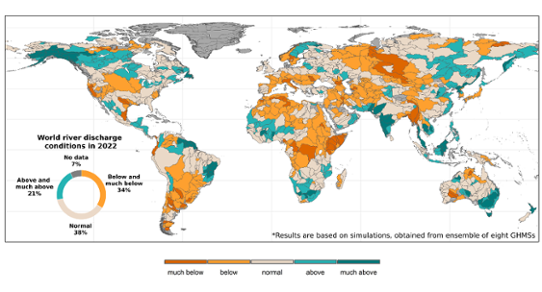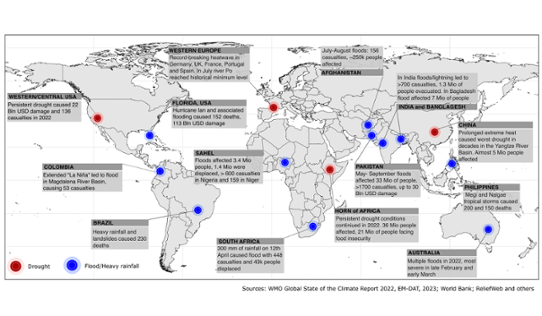“Droughts and extreme rainfall events are wreaking a heavy toll on lives and economies. Melting snow, ice and glaciers have increased hazards like floods and threaten long-term water security for many millions of people. And yet, far too little is known about the true state of the world’s freshwater resources”, WMO writes in a pressrelease about the new report ”State of Global Water Resources 2022”.
WMO makes an annual analysis of the global water situation to follow up the ongoing changes. In this year's report, WMO calls for a fundamental policy shift and says there must be improved monitoring, data sharing, cross-border collaborations and assessments of water resources - and an accompanying increase in investments to facilitate this.
SMHI's hydrological researchers have contributed with data and knowledge
SMHI has contributed to the report and the global analysis in several ways.

- We have proposed what the report could focus on and how the analyzes could be carried out, says Jafet Andersson, researcher at the Hydrology Research unit at SMHI.
- We have also delivered data and metadata from our hydrological calculation model World-Wide HYPE as a basis for the report. Specifically, it concerns simulated water flow for the Earth's land areas, except Antarctica, with relatively high geographic resolution even where there are no measurements for the period 1991–2022. This is then used in the report to understand how the water resources in 2022 were in relation to previous years, Jafet Andersson says.
The World-Wide HYPE model is one of about ten global models that have been used in a hydrological model ensemble. In some large areas, observations are missing. But in the areas where several different calculation models give similar results, the message is judged to be credible.
“A comprehensive, and consistent overview of water resources worldwide”
With WMO's report, the international community now gets a summary of how the earth's water resources are changing and what happened in 2022. The report includes, among other things, an overview of the biggest extreme events during the year and which areas were relatively dry or wet.
“This WMO report offers a comprehensive, and consistent overview of water resources worldwide, highlighting the influence of climate, environmental, and societal changes,” says WMO Secretary-General Prof. Petteri Taalas, in the pressrelease. He also says:
“Glaciers and ice cover are retreating before our eyes. Rising temperatures have accelerated – and also disrupted – the water cycle. A warmer atmosphere holds more moisture. We are seeing much heavier precipitation episodes and flooding. And at the opposite extreme, more evaporation, dry soils and more intense droughts”.
Key Findings (a selection)
- In 2022, over 50% of the global catchment areas experienced deviations from normal river discharge conditions. Most of these areas were drier than normal, while a smaller percentage of basins displayed above or much above normal conditions.
- More than 60% of major water reservoirs saw below or normal inflow, which provides a challenge for providing water to all users in an increasingly variable climate.
- Europe saw increased evaporation and decreased soil moisture and river flows during the summer because of a major heatwave and drought. This led for example to challenges in agriculture.
- The European Alps witnessed unprecedented levels of glacier mass loss.
- Severe droughts impacted many parts of Europe in the summer of 2022, posing transportation challenges in rivers like the Danube and Rhine and disrupting nuclear electricity production in France due the lack of cooling water.
- Navigation on the Mississippi River in the USA was affected by the extremely low water levels, as a result of a continuous drought in the USA.
- Severe drought in the Yangtze River Basin in China led to much lower than average river discharge, inflow to reservoirs, and soil moisture.
- Prolonged drought led to a major humanitarian crisis in the Horn of Africa. By contrast, the Niger Basin and much of South Africa recorded above-average river discharge, linked to major flood events in 2022.
- A mega flood hit the Indus River Basin in Pakistan, killing at least 1 700, affecting 33 million and causing an estimated more than US$ 30 billion in economic losses.

